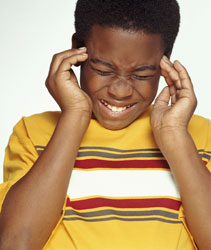It is often assumed that migraine headaches are reserved for people with a family history of migraines and that those who are afflicted by those disabling headaches are usually adults. When a child has the symptoms of migraine headaches it is usually a source of grave concern to the parents. Dr. Lewis reported about his findings at a meeting which was sponsored by Rady Children’s Hospital. He has seen many young persons who suffer of headaches and pointed out that the greatest fear of the patient and the parents, is the thought of a developing brain tumor. If a patient has been having headaches for half a year or two years and has had an entirely normal neurological exam, Dr. Lewis can reassure the patient that there is no brain tumor. Breaking the vicious cycle of fear by reassurance often lifts a load of the patient’s back and things may settle down. About 11% of children in the age group of 5 to 15 years have migraine type headaches. The incidence has a peak at 12 years in boys and at 14 years in girls. Migraines have different criteria than headaches: there are at least 5 lifetime attacks that have a least two of the following symptoms: severe aches on both sides of the head, the front or on one side only, throbbing aches, moderate to severe pain that gets worse with activity. At least one symptom of the following has to be present: either light sensitivity, sensitivity to noise, nausea and vomiting. Dr. Lewis reports that proper sleep habits can make a difference. Too little, too much or inconsistent sleep is closely associated with the frequency of migraines. He cited the example of a sixteen year old who started having migraines after school ended at the end of June. She stayed up late and slept till noon. Once she returned to a regular sleep cycle she did a lot better. Eating patterns can play a role too. One of the common stories is the student skipping lunch and developing a headache about an hour later. Other migraine triggers can be sensitivities to certain foods, altitude changes, weather, motion sickness on a trip, excitement, dehydration and learning problems. Dr. Lewis reported that many of the very young patients age 4 to 5 with migraines may have attention-deficit hyperactivity disorder. If the performance problems are addressed headaches will resolve in 80 to 90% of the time. Headaches can also be linked to emotional aspects, peer problems at school, family problems or depression.
There is no drug that is officially approved for migraines in children. The medication that has been studied most closely is ibuprofen. A controlled trial of 7.5 mg/kg showed a response of 76 %. Acetaminophen with a dose of 15 mg/kg was studied in patients aged 4 to 16 years. The response was 54%. Neither of those two medications showed any adverse side effect. Sumatriptan nasal spray was well tolerated, showed a 1 hour response of 58%, had no side effects, but a bitter aftertaste. It was also pointed out that in a study oral sumatriptan and placebo scored the same. It is obviously most important to get to the root of the problem and eliminate the triggering factors after which medication can be used. The general consensus is to treat the attacks rapidly and consistently, get the patient back to his or her daily functioning, minimize backup medications and make sure that there are minimal or no adverse side effects.
More information about:
1. Attention-deficit hyperactivity disorder: http://nethealthbook.com/mental-illness-mental-disorders/developmental-disorders/attention-deficithyperactivity-disorder/
2. Migraine headaches: http://nethealthbook.com/neurology-neurological-disease/common-causes-headaches/migraine-headache/
Reference: Presentation at Annual Advances in the Practice of Pediatrics: San Diego 2008; Feb. 22-24, Hilton La Jolla
Last edited November 3, 2014






